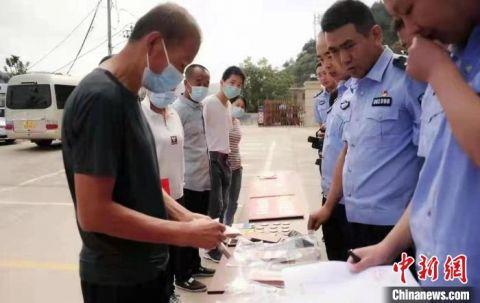China"s Shenzhou-16 manned spaceship, atop a Long March-2F carrier rocket, blasted off from the Jiuquan Satellite Launch Center in northwest China at 9:31 a.m. on May 30, sending three astronauts to the country"s space station combination.
At 4:29 p.m. on the same day, the spaceship successfully docked with the radial port of the core module Tianhe of the space station combination. The crew members Jing Haipeng, Zhu Yangzhu and Gui Haichao then entered the core module, marking China"s second in-orbit crew rotation.
This screen image shows the Shenzhou-15 and Shenzhou-16 crew taking group pictures inside the core module Tianhe of China"s space station. (Photo from the official website of China Manned Space)
(相关资料图)
The Shenzhou-16 is the first crewed mission for the application and development stage of China"s space station, during which the Shenzhou-16 and Shenzhou-15 crews will start a new round of in-orbit crew handover.
It is reported that the Shenzhou-16 crew will perform extravehicular activities, conduct in-orbit tests and experiments, and carry out equipment installation, debugging, maintenance and repair.
The Shenzhou manned spacecraft and the Long March-2F carrier rocket again make a perfect pair. Together, the two have made remarkable contributions to China"s manned space exploration.
Shenzhou is the only manned round-trip spacecraft model in China. It plays a vital role in safeguarding the safety of astronauts.
Centering on the 14 sub-systems of the spaceship"s orbiting, return and propelling capsules, the development team of Shenzhou from China Aerospace Science and Technology Corporation (CASC) has made more than 100 technical improvements and upgrades over the previous Shenzhou spacecraft, with an aim to informationize the spaceship"s data connectivity, digitalize its cable assembly and layout, and make the monitoring of key parameters more intelligent.
As China has kicked off the application and development stage of its space station, the country now carries out crewed missions on a regular basis with a frequency of twice a year, up from one launch every two to three years in the past.
As the first one among a new batch of upgraded Shenzhou spacecraft, the Shenzhou-16 was designed in pursuit of efficiency and quality. For instance, after years of efforts, scientific researchers abandoned the piece-by-piece handmade production model of multi-layer insulation, known as the "overcoat" of spacecraft, and opted for digital designing and an automated production line.
The Long March-2F carrier rocket is the only manned launch vehicle presently in service in China. It has succeeded in all its missions.
"Compared with the Long March-2F Y15 carrier rocket, the Long March-2F has made 20 technical upgrades," said Liu Feng, deputy chief designer for the Long March-2F launch vehicle with the CASC China Academy of Launch Vehicle Technology.
According to him, the development team further lowered the fault rate of the rocket and strengthened the rocket"s reliability by improving its techniques.
The larger weight and size of the combination made the docking this time more difficult. To solve this problem, the CASC research team optimized the Shenzhou-16 spaceship"s navigation and control system through specialized analysis and simulation.
Living in space is a challenge for astronauts as their health conditions may be affected by the space environment. A set of health monitoring devices is needed to check their heart rate, breath, body temperature, blood pressure and other indices.
Such devices on the Shenzhou-16 spaceship, developed by an institute under the CASC, constitute a data processing center for the physiological information of astronauts that monitors and safeguards astronauts" health conditions.
Compared with general medical monitoring devices, the ones on the Shenzhou-16 are much more reliable and safer. Apart from monitoring health conditions, they can also store, transfer and process relevant information, so that ground medical staff are able to guide astronauts to cope with health emergencies.
Pressure relief valves, liquid shut-off valves, physiological signal test kits and ECG recorders are also onboard with the Shenzhou-16 crew this time. These technologically mature products have joined multiple flight verifications and missions of Shenzhou spacecraft.
来源 人民网
编辑 郑康宁
关键词:











